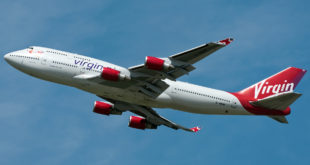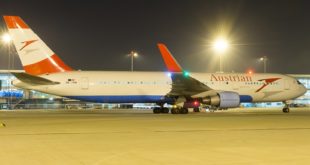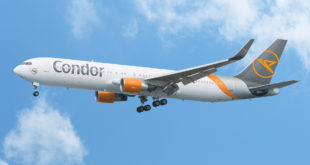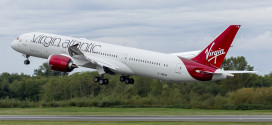Britain’s other major carrier, Virgin Atlantic, rather unexpectedly, announced a seasonal, thrice-weekly service between Manchester and New Delhi starting Winter 2020. The new service will begin from the 26th of October 2020 operating on Monday, Thursday and Saturday on an ex-Air Berlin A330-200 aircraft.
Virgin Atlantic added four of these aircraft to its fleet starting March 2018 to deal with capacity constraints caused due to issues with the Boeing 787’s Rolls Royce engines. These aircraft feature all the signature Virgin Atlantic cabins i.e. Economy, Premium Economy and Upper Class. However, the Upper-Class cabin on these aircraft offers all forward-facing seats (same as Air Berlin) unlike the herringbone layout found on the A340-600, A330-300, B787-9 and B747-400 fleet.
Due to slot constraints at London’s Heathrow airport, Virgin Atlantic has had to look beyond London’s largest airport for growth. The airline which began operations from London Gatwick in 1984 continues to maintain a sizeable flying programme at the airport even today. The airline has also built a sizeable presence at Manchester airport over the last couple of years with flights to New York, Barbados, Orlando, Los Angeles, Atlanta, Boston and Las Vegas in the summer months. The airline is investing significantly in the airport experience at Manchester with the opening of their flagship lounge, the Clubhouse shortly.
The Trans-Atlantic Focus
As the name suggests, Virgin Atlantic has traditionally focused on flights across the pond to North America since it began operation. The airline has over the years tried to diversify its route network and met with limited success in its endeavours. The airline has in the past operated flights to Sydney (via Hong Kong), Mauritius, Dubai and Tokyo. These routes did not survive the unending competition from larger network carriers in Europe, the Middle East and Asia.
The Trans-Atlantic market, however, can be extremely challenging in the winter months when demand is tepid outside of the Christmas and New Year holiday period. Hence, airlines redeploy capacity in these months.
The thrice-weekly service to Delhi is the ideal filler to Virgin’s winter schedule out of Manchester.
Minimal Start-up Costs
Virgin Atlantic has a full-fledged sales team based out of New Delhi which has successfully handled the airlines operations from India to London Heathrow for two decades. This helps reduce route start-up costs considerably. Starting March 29th 2020, Virgin Atlantic will be operating twice daily from London Heathrow to New Delhi. Increased presence at the Delhi Airport helps the airline negotiate better deals with vendors and service providers at the airport.
All in all, the seasonal service will enjoy cost benefits which would help route profitability.
Incentives
Airports the world over are known for offering various incentives and discounts to airlines to bag a particular route/service.
This seasonal service from Virgin Atlantic connects two airports which have not had non-stop air connectivity in the recent past. Both Manchester and Delhi airports would have undoubtedly offered the airline extremely attractive terms for this service.
Schedule
Virgin Atlantic plans to operate as per the following schedule:
| Origin | Destination | Frequency |
| Manchester
(1640 local time) |
Delhi
(0605 local time) |
Mon, Thu, Sat |
| Delhi
(0810 local time) |
Manchester
(1210 local time) |
Tue, Fri, Sun |
This schedule is extremely limited and would not appeal to high yielding business passengers who prefer a certain amount of flexibility when flying. The airline has, however, retimed flights to New York JFK and Atlanta from Manchester to coincide with the launch of flights to New Delhi. These flights will now depart late in the afternoon ensuring two-way connections to the seasonal Delhi service. There will be connections available on Flybe (soon to be rebranded Virgin Connect) too within the UK.
The airline will be relying primarily on O&D traffic and leisure travellers who frequent India in the winter months.
Conclusion
Route planners at airlines constantly evaluate where assets i.e. aircraft and crews, when deployed would bring in optimum returns. The extremely challenging winter months for the Trans-Atlantic market coupled with unserved O&D demand on the Manchester – Delhi route and minimal route start-up costs are primarily responsible for the airline launching this seasonal service.
Flying via various hubs in the Middle East or Europe is tedious and time-consuming. Hence, O&D passengers would much rather prefer this non-stop service.
The yields on this flight will be significantly lower in the premium cabins when compared to services offered by the airline from London Heathrow to India. As per preliminary figures from Sabre Market Intelligence, the Manchester – New Delhi airport pair had 57,300 two-way passengers in the last year. This O&D demand along with connections to two large US cities i.e. New York (JFK) and Atlanta (ATL) will guarantee decent loads on this flight.
 Bangalore Aviation News, Reviews, Analysis and opinions of Indian Aviation
Bangalore Aviation News, Reviews, Analysis and opinions of Indian Aviation



